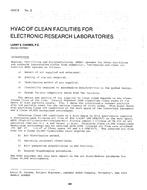Description
Heating, Ventilating and Air-Conditioning (HVAC) systems for clean facilities and research laboratories differ from commercial, residential and other industrial HVAC systems as follows:
a) Amount of air supplied and exhausted.
b) Quality of the air supplied.
c) Distribution method of air supplied.
d) Flexibility required to accommodate modifications in the system design.
e) System failure completely shuts down the facility.
The amount and quality of air supplied to clean rooms depends on the cleanliness class of the room. Federal Standard 209B classifies clean rooms on the basis of dust particle counts. Fig. 1 shows the relationship between particle size and, particle count for the various classes of clean rooms. This paper deals with providing Class 100 conditions at the work space of the laboratory equipment and a Class 10,000 background environment.
Obtaining Class 100 conditions on a work space’in this application requires a continuous HEPA filtered air, flow of 460 l/s/m2 (90 CFM/ft2) on the work space. HEPA (High-Efficiency-Particulate-Air) filters remove a minimum of 99.97% of all particles that are 0.3 m and larger in size. Obtaining Class 10,000 cleanliness background environment may be obtained with HEPA filtered air flow rate of between 230 and 13 1/s m2 of floor space (45 and 2.5 CFM/ft2). The selected air flow rate for a Class 10,000 cleanliness level depends on:
1) Air distribution method.
2) Operating personnel cleanliness.
3) Dirt generating possibilities in the facility.
4) General housekeeping procedures.
The HVAC engineer can only have impact on the air distribution parameter for Class 10,000 environments.
Product Details
- Published:
- 1981
- Number of Pages:
- 10
- File Size:
- 1 file , 1000 KB
- Product Code(s):
- D-CI-81-05-2
- Note:
- This product is unavailable in Russia, Belarus




